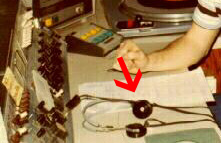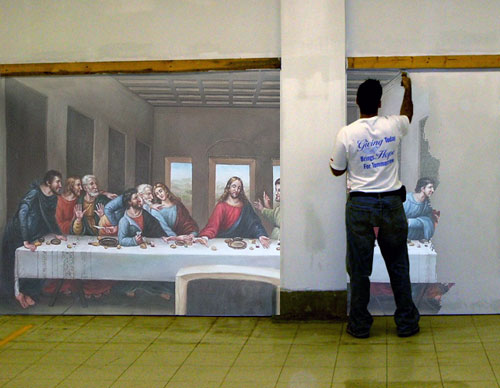Learfield’s Jeff Martin makes work fun during United Way “volunteer day” a couple of years ago.
Monthly Archives: April 2010
The secret to Farmville’s popularity
“The secret to Farmville’s popularity is neither gameplay nor aesthetics. Farmville is popular because in entangles users in a web of social obligations. When users log into Facebook, they are reminded that their neighbors have sent them gifts, posted bonuses on their walls, and helped with each others’ farms. In turn, they are obligated to return the courtesies. As the French sociologist Marcel Mauss tells us, gifts are never free: they bind the giver and receiver in a loop of reciprocity. It is rude to refuse a gift, and ruder still to not return the kindness.[11] We playFarmville, then, because we are trying to be good to one another. We play Farmville because we are polite, cultivated people.” — From an essay by y A. J. Patrick Liszkiewicz
I’ve never played Farmville. Or any other Facebook game. I don’t have a Facebook account anymore and find myself unable to explain why I do not. So it’s hardly fair to use this thoughtful essay as an explanation. But the very essence of Facebook seems to be social obligation. I hate obligations and avoid them wherever possible.
Facebook/Farmville fans can tell me where Mr. Liszkiewicz misses the mark with his essay.
The One True Faith. Mine.
I’ve always wondered how deeply religious people could be so certain their “faith” was the real deal and everyone else’s was bogus. Brian Hines wonders, too:
“People will reject unsubstantiated claims in holy books… except the book they believe in. People will reject miracle stories… except miracles related by their own faith. People will reject the divinity of living prophets or messengers of God… except the person they accept as a genuine spiritual teacher.
Every religious believer, aside from the few who are genuinely open-minded, considers that he or she has found the One True Faith among the 4,199 or so false faiths. Yet how is this possible, logically or realistically?
It’s like Garrison Keillor’s Lake Woebegon, where all the children are above average.
There are good reasons for belonging to a religious, spiritual, or mystical group. But having a lock on cosmic truth isn’t one of them. Nobody knows what lies at the heart of reality, or even if there is such a thing: a heart, a core, a central truth.
So the only honest attitude is “I don’t know.” Along with, “You don’t know either.” This leaves us all on the same unknowing level.”
Why radio news guys don’t do social
Papper: Radio News Does not Make Use of Social Media from Poynter Institute on Vimeo.
From Mashable: “Although Facebook and Twitter are popular with TV stations, only 27% of radio newsrooms use Twitter and 1% have a Facebook page. The survey’s conductor, Robert Papper of Hofstra University, said the contrast in usage is due to staff size. “If you had a staff of three or more, you were involved in a number of social networking things. If you did not hit that magic number you were not involved.” He explains why radio stations do not participate more in social media in the video clip above.”
War is (expensive as) hell
“Software Is Media”
As software has moved from running on local machines to running in the browser a number of important things have happened. One of the most important changes is software has become media.
Like other forms of media, software produces an emotional reaction when we use it. Software needs to have a “voice.” It needs to be more than a simple utility. We need to feel something when we use software. The best software does this incredibly well.
Like media, the interfaces that present software to us need to be stylized, designed, and elegant. Software can be beautiful and the best software is beautiful.
And like media, the most important measurement for software today is the number of engaged users. The more engaged users a piece of software has, the more impactful it can be.
Once we’ve begun to treat some of the software in our lives as media, we are going to treat all the software in our lives as media. And the software that is ugly, void of emotion and voice will not work as well for us. So I believe all software is media and will be seen as such by its users.
Carpenter’s Tools
 When I began working at KBOA in 1972, they were using the same basic style of headphones that they had been using for 20 years. WWII era Bakelite’s designed for durability, rather than fidelity or comfort.
When I began working at KBOA in 1972, they were using the same basic style of headphones that they had been using for 20 years. WWII era Bakelite’s designed for durability, rather than fidelity or comfort.
When they became available (a couple of years later?) I bought a pair of Sennheiser HD 414’s. As I recall, I paid about $60 for them, out of my own pocket. A lot of money in those days (I was making about $14K when I left KBOA in 1984).
But they were wonderful. Light, soft foam ear pieces… and they sounded GREAT. The music sounded great and I sounded great. I looked forward to putting those headphones on.
In the nearly 40 years since, I have purchased a lot of what I considered to be the “tools of my trade.” Microhones; my first computer; digital audio recorders; laser printer; CD drive; video cameras; laptops; and –most recently– the iPad.
I have always looked on these purchases as investments. Not in my company, rather in me. I could have waited until the company thought it made sense to purchase these tools but I was impatient. And I was right. The things I learned (still learning) usually improved my skills and enhanced my value.
Most of my co-workers throughout the years took a different view. If the company wanted them to have and use the latest tools, the company should pay for them. Can’t argue with that.
But I’ve always thought of these purchases as the “carpenter’s tools.” A carpenter friend once explained to me that master carpenters would not think of using someone else’s tools. They took pride in the things they built and insisted on having and using their own tools, that went with them from job to job.
And, if you have a good accountant, you can take the expense as a deduction. Happy Tax Day.
Minnesota school replacing text books with iPads
The Gibbon-Fairfax-Winthrop (Minnesota) School Board approved $265,000 to purchase 230 iPads for students, upgrade all school buildings with Wi-Fi and provide technical training for everyone starting next year.
Apple Computer is providing the school with some assistance. If this works out, the school in Winthrop could become a model for the nation. Bet this isn’t the last time we see this.
Think of the possibilities.
Tests are on PW protected website. Software could determine right/wrong answers on the T/F and multiple choice questions. Huge time saver for teachers. Parents could see student’s answers to help them.
Religion as road maps
“Religions are like different maps whose routes all lead to the collective good of society. Some maps take their followers over rugged terrain. Other maps have easier paths. Some of the travelers of each route will be assigned the job of being the protectors and interpreters of the map. They will teach the young to respect it and be suspicious of other maps.
“Okay,” I said, “but who made the maps in the first place?”
“The maps were made by the people who went first and didn’t die. The maps that survive are the ones that work,” he said.
At last, he had presented a target for me to attack. “Are you saying that all the religions work? What about all the people who have been killed in religious wars?”
“You can’t judge the value of a thing by looking only at costs. In many countries, more people die from hospital errors than religious wars, but no one accuses hospitals of being evil. Religious people are happier, they live longer, have fewer accidents, and stay out of trouble compared to nonreligious people. From society’s viewpoint, religion works.”
— From God’s Debris by Scott Adams
Steve Safran on RTDNA@NAB 2010
“The future of broadcasting” is the title or subtitle or subtext of nearly every panel here. But I’m not seeing a lot of the future. I’m seeing and hearing people who want to keep a hold onto the past. They want to do it in some futuristic ways, sure, but using a template that has passed its expiration date.”
“…as the RTDNA winds down its relationship with NAB, I’m a little sad. When I first started coming to this convention in the early 2000s, the discussions were about “the future.” The discussions are still about “the future” except it’s all Back to the Future. 3D. Protecting journalism from the hoards of camera-toting iPhoners. Broadcasting television in a slightly different way. Fundamentally, the discussion may be about the future, but it’s not nearly futuristic enough.” — Full post here.

